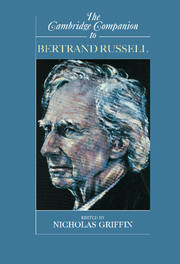Book contents
- Frontmatter
- Introduction
- 1 Mathematics in and behind Russell’s Logicism, and Its Reception
- 2 Russell’s Philosophical Background
- 3 Russell and Moore, 1898-1905
- 4 Russell and Frege
- 5 Bertrand Russell’s Logicism
- 6 The Theory of Descriptions
- 7 Russell’s Substitutional Theory
- 8 The Theory of Types
- 9 Russell’s Method of Analysis
- 10 Russell’s Neutral Monism
- 11 The Metaphysics of Logical Atomism
- 12 Russell’s Structuralism and the Absolute Description of the World
- 13 From Knowledge by Acquaintance to Knowledge by Causation
- 14 Russell, Experience, and the Roots of Science
- 15 Bertrand Russell
- Selective Bibliography
- Index
- Series list
6 - The Theory of Descriptions
Published online by Cambridge University Press: 28 May 2006
- Frontmatter
- Introduction
- 1 Mathematics in and behind Russell’s Logicism, and Its Reception
- 2 Russell’s Philosophical Background
- 3 Russell and Moore, 1898-1905
- 4 Russell and Frege
- 5 Bertrand Russell’s Logicism
- 6 The Theory of Descriptions
- 7 Russell’s Substitutional Theory
- 8 The Theory of Types
- 9 Russell’s Method of Analysis
- 10 Russell’s Neutral Monism
- 11 The Metaphysics of Logical Atomism
- 12 Russell’s Structuralism and the Absolute Description of the World
- 13 From Knowledge by Acquaintance to Knowledge by Causation
- 14 Russell, Experience, and the Roots of Science
- 15 Bertrand Russell
- Selective Bibliography
- Index
- Series list
Summary
Russell's theory of descriptions was first published in his 1905 essay, “On Denoting”, which is surely one of the two or three most famous articles in twentieth-century analytic philosophy. It has been described as “a paradigm of philosophy”, and has been employed by many later analytic philosophers, such as Quine, although disputed by others, perhaps most notably Strawson. Writing in 1967, an astute commentator said: “In the forty-five years preceding the publication of Strawson's 'On Referring', Russell's theory was practically immune from criticism. There is not a similar phenomenon in contemporary analytic philosophy”.
What is the theory which has excited such interest and acclaim? To put it briefly and more or less neutrally, it is a method of analyzing definite descriptions, also called singular descriptions, i.e., phrases, in English typically beginning with the word “the”, which pick out or purport to pick out a single (“definite”) object – e.g., “the man who broke the bank at Monte Carlo”, or “the first President of the USA”. Many philosophers who have accepted the theory of definite descriptions, including Russell himself, have also treated some or all proper names in similar fashion. They are taken to be disguised definite descriptions, and then subjected to the same analysis as overt definite descriptions. Definite descriptions may be contrasted with indefinite descriptions, which do not purport to pick out any particular number of objects – e.g., “any President of the USA”. Note that while the two phrases “the even prime number” and “any even prime number” in fact direct our attention to the same object – the number two – the first is a definite description, while the second is an indefinite description.
- Type
- Chapter
- Information
- The Cambridge Companion to Bertrand Russell , pp. 202 - 240Publisher: Cambridge University PressPrint publication year: 2003
- 5
- Cited by



